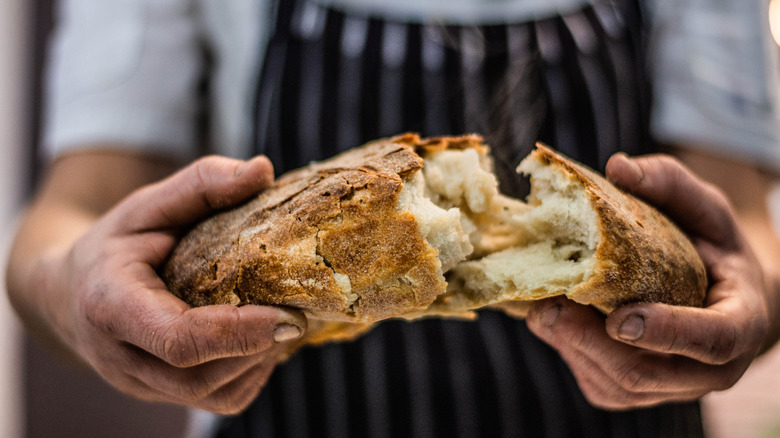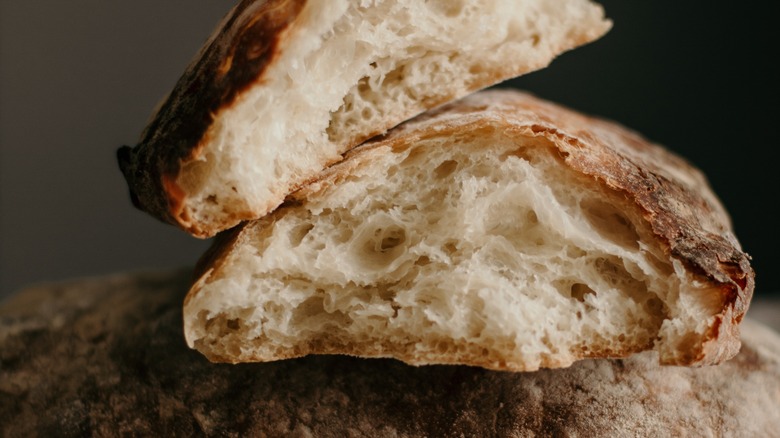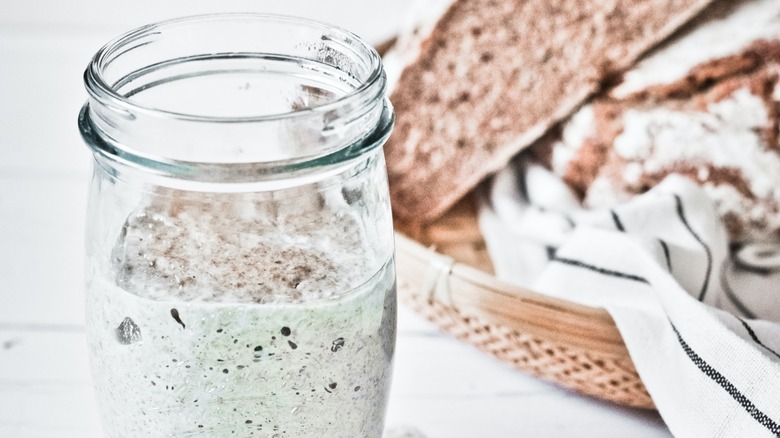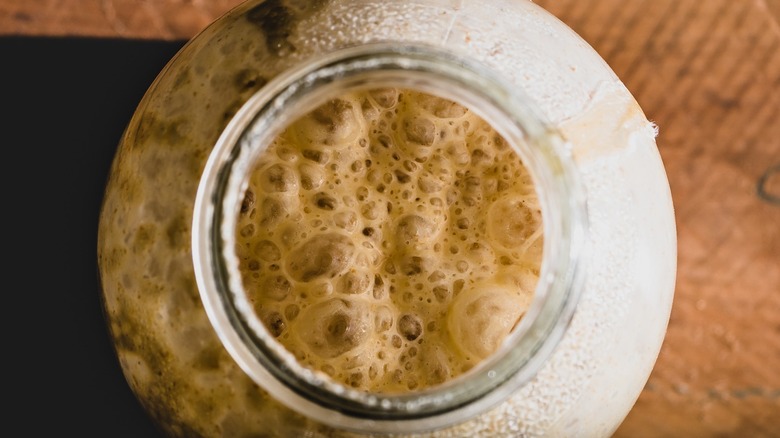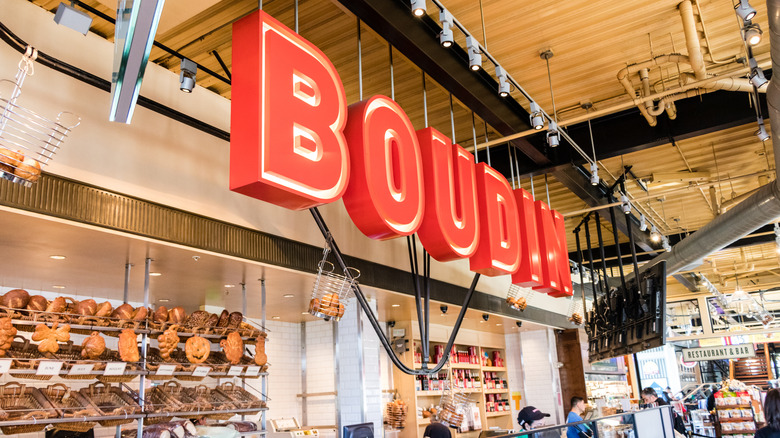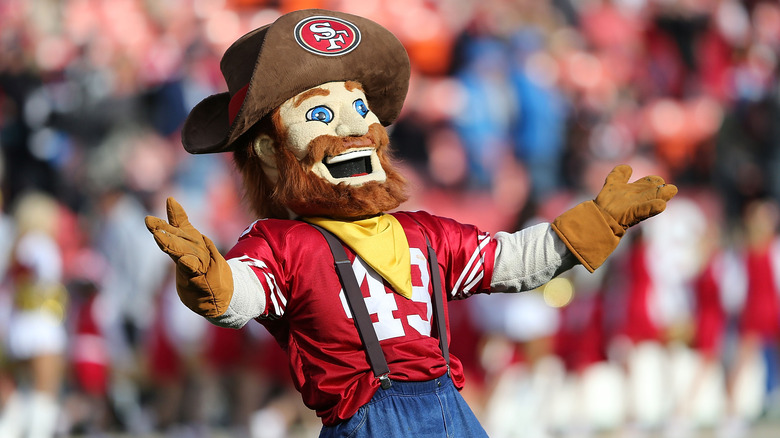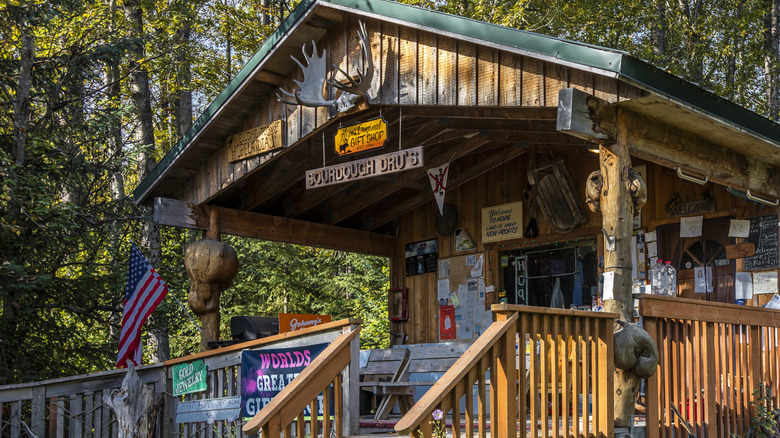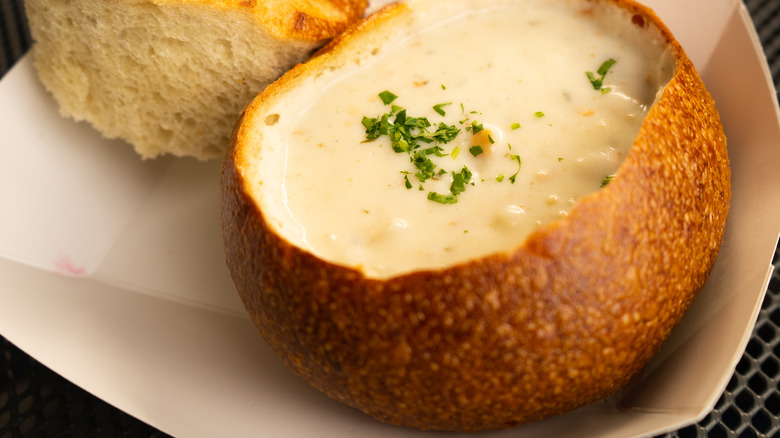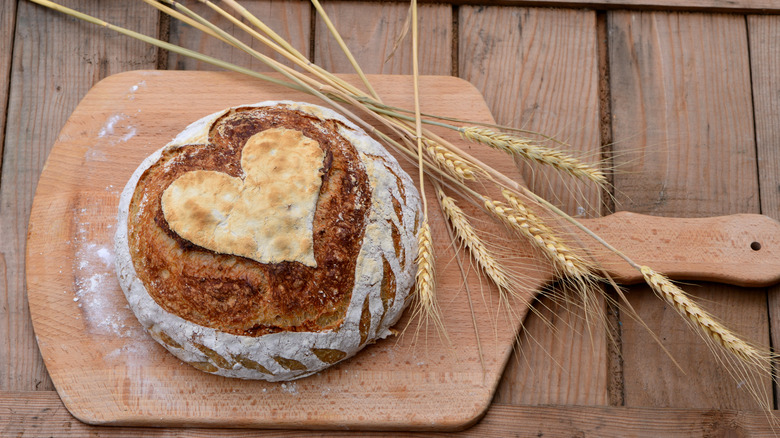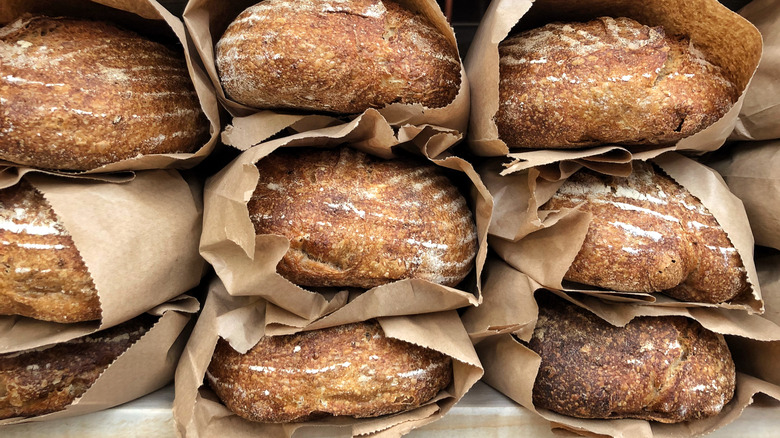The Untold Truth Of Sourdough Bread
We may receive a commission on purchases made from links.
The tangy taste of sourdough, with its chewy texture, originates from thousands of years ago. Sourdough was baked by the ancient Egyptians, and unlike other early flour-and-water breads, sourdough had a somewhat lighter texture. These early bakers also realized that by keeping back some of the dough, they could easily produce more dough, and so on. The first sourdough likely came to be by accident; it's thought that wild yeast came into contact with bread mixture that was left out, leading to the discovery of sourdough.
The public's love for sourdough is rising — pun intended! One Nielsen report showed that sourdough sales in the U.S. reached $325.9 million in 2019 (via CNBC). Meanwhile, home-made sourdough has become a big deal too. While many home bakers gave sourdough a try during pandemic lockdowns, some people took it a step further. Seamus Blackley, creator of the Xbox, combined his interests in Egyptology and baking by extracting yeast from an ancient pot and using a 4,5000-year-old recipe to recreate the bread of the ancient Egyptians.
But sourdough's come a long way since ancient times. It was the food of the gold prospectors in the U.S. during the Gold Rush, and became a meditative practice during the challenging pandemic lockdown periods. Keep reading to find out more about this bread that's rich in history — and health benefits!
What is sourdough?
While you may have heard about sourdough and maybe bought a loaf or sampled it at a restaurant or cafe, unless you have actually made sourdough, you may not be aware of what it actually is. There are two types of bread. First, unleavened bread is made without any type of raising agent, whether that be yeast or a sourdough starter that causes the dough to rise. Examples are Indian chapatis, Mexican tortillas, and matzos. Some flat breads, though, are actually leavened, such as pita bread and pizza dough.
Unlike unleavened bread, leavened bread needs an ingredient to make the dough expand, which is generally dry or fresh yeast. With sourdough, however, a preferment is made, which is a fermented dough mix that is made from flour and water. During the fermentation process, the bread rises, as it would with added yeast, because wild yeast and bacteria, which are present in the flour in a natural form, have grown. This sourdough preferment is added to over time and stored, and serves as the basis of what is called a sourdough starter. It is this sourdough starter, and how the preferment is looked after, that's at the heart of sourdough baking and the distinctive taste of this delicious bread. Such is the care some home bakers take with this process in Sweden that when they take a vacation, they also book their sourdough starter in for a stay somewhere too!
What is a sourdough starter?
A sourdough starter is the mix used to make this unique leavened bread. In effect, a starter is made in order to make sourdough bread, and the science behind this is that it's a culture of microbes that are created by yeasts and bacteria. A starter jar is usually wide-mouthed and made from glass so that the ingredients inside can be easily seen. Flour and water in equal amounts are mixed in the jar to create the sourdough starter. This will create the right environment for fermentation.
The next step is to remove some of the starter each day and get rid of it, while re-feeding it daily with more flour and water. Over time, the carbon dioxide that is released enables the dough to rise before it is baked, and this process is what gives sourdough its distinctive taste and texture. A starter takes time to mature, so how do you know if a sourdough starter is ready to be made into bread? First, the starter will start to bubble more and make a popping sound when it's fed, while a liquid may start to appear at the surface. At the same time, if the volume of the starter doubles in a matter of hours, then this is a real sign it's ready to go. There's also a simple test whereby a spoonful of starter is dropped in water — if it floats, it's ready to use. Any remaining starter can be stored in the fridge.
Solving sourdough starter problems
Nourishing a sourdough starter is about maintaining it and looking out for telltale signs that it's active and growing in size. Sourdough starter problems can often be easily solved with good maintenance and an understanding of what potential issues might arise. For example, if there doesn't seem to be a lot of bubbles and the mixture is not really rising and falling, as it should with the microbial ecosystem feeding, then the feeding amounts may not be quite right. Depending on the size of the starter, it will need a particular amount of flour and water added each day so that the starter is properly activated. Not feeding a starter daily or moving it around so that the temperature is either too hot or too cold can also slow down the activity as well.
A starter might also produce a liquid called hooch on top, which can be mixed back in. Hooch is usually a sign that the microbes need more food. More flour and water can be added to the mix to keep the starter going when this happens. If the starter is really neglected, though, then mold may appear, possibly in the forms of pink and orange streaks in the starter. If this happens, the culture has gone bad and needs to be thrown away. Views on how to store your starter properly differ, but once it's mature, you can keep it in the fridge.
Sourdough during the California Gold Rush
It was the during the California Gold Rush of the late 1840s and early 1850s that miners flocked to San Francisco, bringing their sourdough starters with them. While some legends claim it was Christopher Columbus who brought the first sourdough to the Americas, and others say it was the Basque immigrants during the Spanish wars, one thing that is certain is that the miners in California loved their sourdough starters. In fact, it became associated with the miners so much that their nickname was "sourdoughs." It is said that the miners would cuddle up to their starters at night to keep them active, and get a loaf baking in a pot on the coals during the day, ready for their return after a hard day's mining.
In 1849, the famed Boudin Bakery was established in San Francisco, and still bakes sourdough to this day, using its own wild yeast. Meanwhile, the miners noticed that San Francisco sourdough tasted tangier and chewier than loaves made elsewhere. This led to two researchers discovering what was at the time, during the 1970s, a microbe that had not been catalogued, and this lactobacillus was subsequently named sanfranciscensis after the city. While it was later discovered the microbe is not actually unique to San Francisco, it still contributes to the city's reputation for incredible sourdough.
Sourdough Sam is a San Francisco NFL mascot
So proud is San Francisco of its sourdough that the city's official mascot for its NFL team, the San Francisco 49ers, is called Sourdough Sam. The larger-than-life character, who has been attending games for over 25 years, is a miner, complete with a cowboy hat, gold scarf, jeans held up by suspenders, and sometimes a miner's pickaxe. However, as blue-collar as Sourdough Sam is, he has been known to dress up on occasion. For example, he sported "Miami Vice"-style garb before heading to the Super Bowl in 2020, carrying a loaf of sourdough in an appearance on "Midday LIVE."
Before Sourdough Sam became the official 49ers mascot, a similarly hairy-faced prospector began making an appearance in the 1970s. Wearing a plaid shirt, suspenders, and a football helmet, he set the mining theme; after all, the 49ers are named after the year 1849, when the Gold Rush first began. The original old prospector even appeared on a 1985 49ers cookbook written by wives of the players to support the American Heart Association.
As the current mascot, Sourdough Sam himself "fuels up with good foods," according to an interview with The Mercury News — we can only hope that traditional sourdough is part of his diet!
The Alaskans have an interesting sourdough history
The Klondike Gold Rush in the 1890s saw over 100,000 miners flock to Canada and Alaska in search of riches. Braving the cold and harsh conditions of these wild frontiers, Ruth Allman wrote in her book, "Alaska Sourdough," that sourdough was a life-saver during these days. She notes that those seeking gold who wanted to pass the Chilkoot Pass had to show the Canadian Mounted Police that they had the sustenance to survive for 12 months. A sourdough starter and flour would accompany them, as a means to supply them with food over the year (via Atlas Obscura).
After the Gold Rush, roads were built heading into Alaska. The Sourdough Lodge was a stopping off place along the way to provide food, warmth and shelter against the harsh Alaskan elements. Before it was destroyed in the early 1990s, it was designated a National Historic Landmark. Meanwhile, Alaskan residents are often called sourdoughs, as long as they've lived in Alaska for a good few winters. The word is often used in the names of businesses to denote that they've been around a long time, too. It is this incredible history that really shows the resilience and pioneering spirit of the American people. It also highlights the potential longevity of a sourdough starter, and how a pot and some flour could be so important to so many lives.
Sourdough is used as a soup bowl
Eating a sourdough soup bowl full of clam chowder down at San Francisco's Fisherman's Wharf is something of a local tradition. However, while this may be an iconic image in this West coast city, the origins of a sourdough bowl actually date much earlier — to 15th century Ireland, in fact. It was in the 1400s that a nobleman apparently presented a duke with a soup-filled bowl made from hollowed-out bread. According to the story, the soup was so well received that the innovative gent was given the funds to open his own shop selling bread-bowl soups in Dublin.
Meanwhile, chowder originated in France as a soup made by fishermen. It made its way into the U.S., where clams became a common ingredient in the dish we now know as New England clam chowder. It was much later that San Francisco added to this foodie legacy, by combining clam chowder and its famous sourdough bread. The bread is rounded like a soup bowl, and is called a sourdough boule.
The health benefits of sourdough
Sourdough is regarded by many health experts and researchers as healthier than many other types of bread. Sourdough contains less gluten to start with, which is great news for those who want to lower their gluten intake. It is also regarded as being easier to digest. Clean Plates reports that the natural yeast in sourdough, unlike that used in other leavened breads, "unlocks the nutrients in wheat." It does this by breaking down phytic acid, which is naturally found in wheat and blocks the body from absorbing wheat's nutrients. Sourdough, though, enables the body to absorb the zinc, magnesium, potassium, and folate found in wheat.
Sourdough is also a good source of niacin and calcium, while studies suggest sourdough lactic acid bacteria releases peptides which demonstrate antioxidant behavior, with research ongoing about how peptides can help in the fight against cancer. Other positive benefits of this type of bread include its lower glycemic index, which has a positive impact on blood glucose levels. In addition, sufferers of irritable bowel syndrome can benefit because of the lower gluten levels and FODMAP carbohydrates in sourdough, which are often a cause of symptoms. Another advantage is that while sourdough has a salty taste, its salt content is lower than that of many other breads, which is ideal for those with blood-pressure issues who are following a low-sodium diet.
Why sourdough has become popular again more recently
Not only has sourdough stood the test of time, it's actually surged in popularity in more recent times. Everybody, it seems, is either making, buying, or simply eating sourdough. The COVID pandemic likely boosted sourdough's popularity, when so many had to stay at home with time on their hands and no dry yeast, and ended up reaching for a bread recipe that only needed water and flour.
In an interview for Electric Lit, Robin Sloan, author of "Sourdough," explains why people are obsessed with making sourdough. "Well, this is what happened to me, and I think it's true for a lot of people, especially people who have lost touch with old foodways: the reality of a sourdough starter is honestly SHOCKING. That it's as much a weird roommate as a kitchen ingredient, I mean. ... And I really do think that, beside being a key part of this iconic (delicious) substance, sourdough starter also offers this broader 'ohhh' about cooking and eating and ... the whole natural world."
The fact that a sourdough starter moves, and is alive, is perhaps what has inspired so many home cooks to give sourdough a try.
